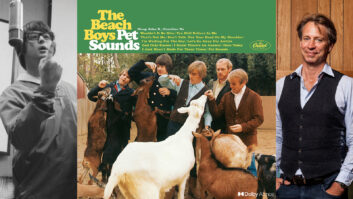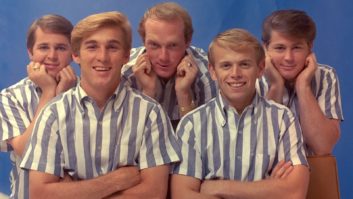Mike Love, lead singer for the Beach Boys, sings into a Shure Beta 58 nightly, while the rest of the band is heard via Telefunken M80s. Very few acts are still a hot ticket half a century after their debuts, but then again, nothing about The Beach Boys is rote. Hot on the heels of last year’s massive box set for the legendary “lost” Smile album, the surviving members will hit the road together in April for the first time in 20 years for a 50th anniversary reunion tour—a jaunt which is expected to be bolstered by a new album, coming later in 2012.

It’s a time of renewal and raised profile for the band, but, in truth, it’s not as if the Beach Boys ever went away. While original members Brian Wilson and Al Jardine have performed on their own in recent times, Mike Love and Bruce Johnston have toured officially as The Beach Boys for years, typically playing a strenuous 120 shows annually. Manning the mixers for all those gigs are Mark Newman at front of house, and John Bracken at the monitors position.
Newman began mixing the band five years ago, and while it could be intimidating to take up the audio reigns on living legends, his audition gig went well in part because he got some insider advice. Bruce Johnston recalled, “First day, I told Mark, ‘Here’s how you mix this band: Make it sound like the jukebox in your favorite bar, and you’ll be all right.’”
It’s good advice, too—in concert, the road-savvy band walks a tightrope between the pristine tracks so thoroughly emblazoned on the American consciousness, and the mild raucousness of a live show. “Our musical director, Scott Totten, tries to keep it as authentic as possible to the record,” said Newman, “whereas I’m trying to make it sound powerful and big, and a live experience like people are used to in the 21st Century—combined with those vocal harmonies and the arrangements and melodies.”
As might be expected with such a demanding touring schedule, the Beach Boys of recent years is one lean touring machine, using local audio gear, backline and even drum kits, at every stop. “They’ve been doing it this way so long that they’ve got preferred vendors and backline companies who send out favorite amps and drum kits for the band,” said Newman.
Still, there are certain things that the group carries to every show— without question, an act known for its vocals is going to carry its own mics. “My buddy Kevin Lemoine was mixing Green Day a few years ago,” Newman recalled. “I went to see his show and asked what he was using on the vocals. He said, ‘I love these mics—they’re Telefunken M80s.’ I called up the company, they sent us some out and we haven’t looked back. With the M80s, they need to be up close to it, but they sound great as a result. The drummer has a Crown Audio C311A headset, which works very well. For Mike Love, we use a Shure Beta 58—he has a unique singing style. It’s not a lot of output and sometimes he holds it 2-3 inches away from his mouth. That requires a lot of gain, so I use a Shure DFR11EQ. It’s a feedback eliminator, and unlike some other models over the past years, this one is very transparent, sounds great, notches just the frequency that’s the problem and lets your EQ stay relatively flat on the channel. I can’t do a show without it.”
With seven people on stage— two guitars, two keyboards, bass drums and Love on vocals—another “must” is a gaggle of personal monitor systems. “I had to get my ear rack down to under 70 pounds in a Pelican Box,” said Bracken. “I have six units and two dividers. When I built the thing, I was calling up companies to find the lightest cable, lightest connectors; I was cutting cords to get weight off; I took the chassis apart because it weighs 3.5 lbs. And I got it all down to 69.5 lbs. I even got a spare wireless unit in there, but for that, I had to take the cover off to cut weight. We’re really limited because we’re flying all the time with what we can actually physically carry so as not to be charged over weight.”
So what’s inside that Pelican Box? “We use Sennheiser G3 wireless, which I absolutely love,” said Bracken. “We also have Future Sonics ear monitors with the new MG6 drivers. We tried some other brands a few months ago to listen to them, but we felt that for a vocal band, the Future Sonics work the best for us. Once in a while, we have to do a wedge show, like if an airline loses the case. The guys like it because it’s kind of rock ’n’ roll, but then afterwards, they’re like, ‘Oh man, my ears are blown!’ They’ve been on ears for a long time, and it’s one of the ways we maintain consistency from show to show.”
Monitor engineer John Bracken (left) and FOH man Mark Newman survey the scene before a show at the NYCB Theatre in Westbury, NY. Another key factor is that they request Yamaha PM5D consoles at every stop. Of course, that’s not always possible; indeed, Pro Sound News caught up with the engineers on an evening that they were using Avid Venue Profiles—“A nice desk,” Bracken allowed. Newman, an analog console stalwart, explained the choice of the PM5D as the standard rider request, noting, “It’s easy to load-in the card, and the control surface is so easy to navigate. Your head’s not buried in the screen during the show, trying to assign something or tweak a compressor, plus the platform is stable.”

Given the opportunity, both engineers would happily take an analog desk, but readily admit that going digital makes the most sense for their production. “Out here, we have to make some concessions with so many fly dates and just getting in there,” said Bracken. “Sometimes at these fairs, you can’t sound check until after 5 o’clock because there’s a tractor pull going on—they can’t run the snakes out! So the digitals do save us, because we load and go.”
One key piece of audio gear that can’t be the same every time, however, is the PA, and as a result, the Beach Boys are heard through every system imaginable, usually at around 98 dB with peaks of 102. “I’m seeing a lot of JBL VerTecs and the usual suspects,” said Newman. “d&b is having more of a presence, I think, too. This year, we’ve had a lot of Adamson, which is nice; had one just the other day. One of the best shows we’ve done with a regional in years, sound-wise, was in a casino parking lot. There were 5,000 people there, and it was XXXX [pronounced Four-X] Audio Systems in Sacramento, California. The PA sounded phenomenal—it was VerTecs just tuned properly; I did minimal EQ. When I got my hands on the board, it was a dream to mix on.”
Typically everything runs smoothly on the Beach Boys’ endless tour, however, which is just as well. “We’re on the road all the time and we try not to kill each other,” laughed Bracken. “We all get along, and they’re good people—Mike Love’s got a great sense of humor.”
So, working with a string of classic songs every night, what’s their favorite to mix? Newman went with “Good Vibrations,” while Bracken mused, “I’m a Beach Boys fan, so I don’t get tired of hearing most of them night in and night out.” However, there’s one song that has a special place in the engineers’ hearts: “Fun Fun Fun.” With a grin, Bracken explained, “We call it ‘Done Done Done’—because it’s the last song of the night!”
Sennheiser
sennheiserusa.com
Future Sonics
futuresonics.com
Telefunken
t-funk.com
Yamaha
yamahaca.com
Vital Stats
The Beach Boys
FOH Engineer:
Mark Newman
Monitor Engineer:
John Bracken
Personal Monitors:
Sennheiser G3 IEM; Future Sonics MG6 ear pieces
Microphones:
Shure Beta 58; Telefunken M80; Crown Audio C311 headset; Countryman DI




